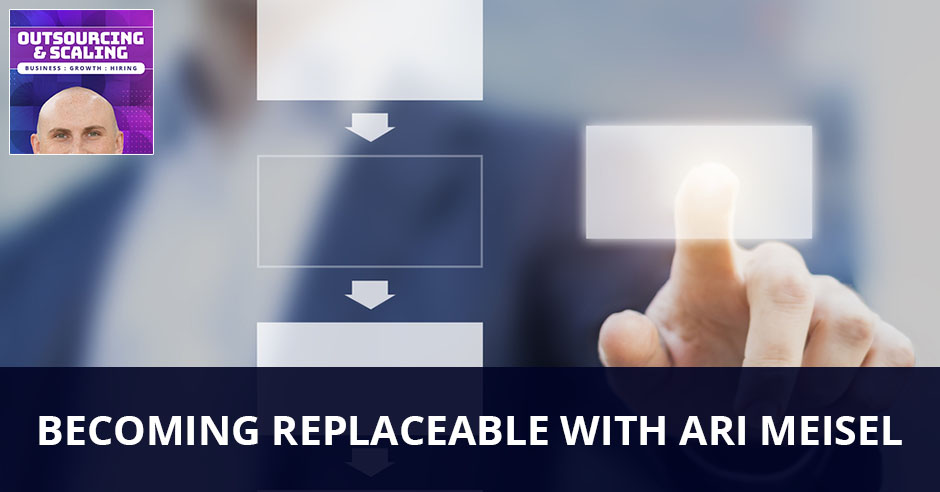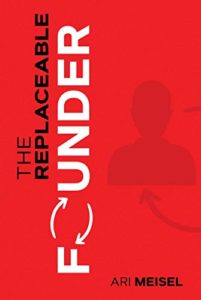


In marketing terms, the term replaceability doesn’t replacing you but being as replaceable as possible. Ari Meisel, a self-described “Overwhelmologist” and the Founder of Less Doing, defines replaceability as seeking more opportunities that can support entrepreneurs to find focus, flexibility, and freedom in their business. In this episode, Ari describes this method of becoming replaceable to help entrepreneurs scale their businesses more effectively. He also talks about building processes, creating SOPs, what he uses Vas for and recognizing certain risks that can come along with using them.
—
Listen to the podcast here:
[smart_track_player url=”https://www.podetize.com/statsapi/www.podetize.com/wp-content/uploads/fileuploads/11-5b145ef137b51b3d1af0633e9305c43d/11/2019/05b119050661a1113a99a2e72bed61ec.mp3″ title=”Becoming Replaceable With Ari Meisel” artist=”Nathan Hirsch” image=”https://freeup.net/wp-content/uploads/2019/04/OAS.png” ]
Download the audio file here.
Becoming Replaceable With Ari Meisel
My guest is Ari Meisel. Ari, how are you doing?
I’m doing great, Nathan.
It’s great to have you on the show. I know you had me on yours back in the day. For those of you that don’t know Ari, he’s a self-described “Overwhelmologist” and the founder of Less Doing. He helps entrepreneurs to have the opportunity and access to whatever their infrastructure can support. Find focus, flexibility, and freedom in their business. The methodology enables founders to become replaceable so they can scale their business. We’re all about becoming replaceable here. First, let’s take a gigantic step back. What was you like growing up as a kid? Were you a straight-A student or were you a rebel? Do you always know that you want to be an entrepreneur?
I started my first company when I was twelve which was website design. I wouldn’t say I was a great student; I did fine in school. I graduated from college and I got a 2.68 GPA. I got in school when I wanted to be in school. When I was twelve, I started the first company. When I was sixteen, I started the second one. When I was seventeen, I started the third one. I was running three companies in high school which didn’t leave a lot of time for schooltime. It also didn’t leave a lot of time for my childhood in some ways. I’m realizing that I feel like I’ve missed out on a lot of aspects in my childhood because I was focused on business, but it was incredibly informative.
What made you go down that entrepreneurial route? What was your first endeavor?

The first company was website design. It’s the story of how a lot of things have gotten in my life. I just fell into them because I was interested in it. When I was twelve, website design was something that either expensive that agencies were doing or kids that were running HTML. I built a couple of websites just for fun. I built one for my father’s art gallery. One of his colleagues came and didn’t have a website for his business. He offered to pay me $500 to build his website, which I did. I thought, “I’ve grown up in the art world and it seems that a lot of people don’t have these things called websites.” I started pushing to do more websites for people in the art world.
I went from there and I started building more, charging more, and so on so forth. The same thing when I was sixteen. I started a tech consulting company. I was good with tech and one of my parents’ friends was like, “Could you help me with this thing with my computer for a few hours? I’ll pay you.” I was like, “Yes, that’s great.” That evolved into me wiring a satellite system into a client’s yacht. Everything started to progress by things that I was good at and liked doing.
Who’s your first hire? How did that go?
Technically, my first hire was one of my friends when I was fifteen, named Emanuel. He’s helped me with the websites, but I wouldn’t consider that officially my first hire. When I got into college, I went to work in construction. I fell into it. I went to visit a friend and saw this property that I had an idea of something I could do with it. I wanted to learn the trades and more about everything that was happening. I had a team of 60 people quickly. I was learning and doing every trade imaginable.
How did it go? The construction business is an interesting business. There’s a lot of turnover and different leadership styles that go into it. I was an aggressive leader. We built things quickly and cheaper. That was definitely an interesting version of it. My first real hire was my assistant coach on my business and is the Director of Customer Experience for us. It was incredible. We grew into our roles together in a lot of ways. I’ve hired a couple of hundred people.
Let’s talk about what you use an assistant for. You said that one of your best hires is one of your most important hires. What is that day-to-day interaction look like? What tasks is he doing for you? What stuff are you taking off of your plate that maybe you’re not good at?
I’ve had VAs working with me for years from the first one that was from a company called AskSunday, which is based in India. I work with two different companies, ChatterBoss and Magic. VAs do a ton of stuff for me. I feel in a lot of ways that they do more for me in my personal life than in my business life. As an entrepreneur, there isn’t that big of differentiation in our brains, yet entrepreneurs often have trouble justifying paying someone to help them in their personal life because there’s no ROI.
At the end of the day, I bring a lot less value to certain activities in my home life than I would in my business life. For example, I have four small children and the VAs have filled out all the paperwork for their camp for the summer and for school stuff. Me doing it doesn’t show more love and I probably won’t do it as well. By having that taken out of the way, I get to spend more time doing what I want to do with my family and also not dreading stopping work because I have to do all these things. On the personal side, that’s that. I have five core members of my team and all the way upwards of 200 contractors that I work with on a regular basis on every possible specialty.
How do you get over that fear factor? I feel like a lot of entrepreneurs are like, “Those are my kids. I don’t want VAs doing anything with that. It’s my business. No one can do it better than me. They’re going to mess it up.” Were you always able to overcome that or is that something that evolved over time?
I quickly saw the benefit, the risk-reward trade-off fast and recognize that there are certain risks that can come along with doing these things. The rewards have been great for me. It’s over and over, it’s never been an issue. It’s a misinformed way of going about it because there’s no such thing as true privacy. Anything that you would share online or over email technically could get hacked. People could find your passwords. All the things that we put in place, like password managers and stuff are going to help to an extent. If we think that by not using a VA, we’re safe, that’s crazy. That always shocked me and that’s a psychology issue. There’s nothing else there. People have trouble letting go of things and have control issues. That never happens.
Entrepreneurs often have trouble justifying paying someone to help them in their personal life because there’s no ROI.
What about the architect of Less Doing? Is that something that you implement at the beginning when you’re starting a business or is that something that you evolve over time?
A little bit of both. We’re not often working with startups who are just starting out and want to do it right that has come up. More often, we’re dealing with companies that have already achieved some level of success and they are seeing an opportunity that is beyond what their infrastructural support. We’re not working with people who need to grind out more leads and figure out more interesting marketing techniques and the real hustle people. We’re dealing with those companies, not necessarily larger but usually, the minimum is if they’re doing $1 million a year on revenue going to $100 million. It depends where they’re at. The big thing is that they have a fire hose of opportunity and they can’t take advantage of it all. It’s the specific thing that we do.
Is that something that the average entrepreneur you find is accepting of or do you feel like most entrepreneurs are trying to do everything themselves and stay inside their business?
The latter. The last book that I wrote is called The Replaceable Founder. We talked a lot about replaceability, not replacing you but being as replaceable as possible. That talks about psychology, that brings up fear for people. This is not just about the founder. It is about everybody in a company. We want to replace everybody up, not out. If you think about that as your goal, then that’s going to force you to put systems and processes in place, delegate where necessary, and systematize. As a methodology, sometimes, it’s a little bit hard to push across the table, but most of the time, people are replaceable like, “That sounds great, but I need more than that.” It’s a focused way that we look at this that we want to make everybody more replaceable.
What’s the best way to make yourself replaceable? Where do you get started in that process?
It depends to some extent on what level is your business in terms of revenue. Generally speaking, we start with creating systems and processes that replace what we do well. After that, we start to look at people that can replace those things. One of the mistakes people often make is that they bring in people first. If you don’t have good systems and processes, you don’t have good documentation of things, you’re going to bring somebody in and you’re going to expect a result that they cannot deliver. You start with the system process. I’ve seen companies that are doing million dollars in revenue and they have eleven employees. That’s crazy to me. There are companies that are at $10 million and have two people. Your company is an incredibly shining example. You have three employees.
We have no employees, but we do have a lot of VAs and a lot of manpower.

You and your partner and that’s it. A lot of people get heavy like, “I need more people,” They want to look in their local area or they want to bring somebody in. I feel that to some extent is fading. You probably have a better macro sense of how this is happening at all. Start looking in those systems and processes and then start looking at people in place of those things as well.
What tips do you have for building out processes or creating SOPs? I feel like a lot of people get hung up there.
Yes, most people do it wrong. The way that most people document a process is that they will show it to somebody and then say, “Go do the thing.” Whether that’s a screencast or a video of them doing some industrial process, we’ve seen that, or something in person and they say, “This is how I do it. Click here. You go do it.” This is a mistake because you’re telling people to copy a copy and we always get errors that way. The right way to do it and the way that we teach it is something that we call our product optimization system. In this case, you show someone how to do it and then you say to them, “Don’t do the process.” You write down the SOP. Write down what you saw and then when you’re done doing that, take it to a third person who hasn’t seen it yet and have them try to do the process.
What we found is it will never ever work, but that’s great because then we get to step three. It says, “Click the big red button.” The person says, “I don’t see a big red button.” You’re like, “Because I’m logged in as admin. You’re not so I got to fix that.” You fix it each level and that could be for a five-step process or a 182-step process. What you end up with is a process that’s bulletproof that you’ve now shown that somebody at a tertiary level can perform it without error. Which means you grab somebody off the street and have them run to those process. At that point, outsourcing is a snap.
I do that with my team leaders. They’re not only responsible for creating the SOPs originally but as processes changed and evolved, they’re responsible for updating them and keeping them updated. When we add someone new to the team, they go through those SOPs and they’re always up to date. I don’t have to go in. When you get to our size, it’s almost impossible for me to spend time in every team writing different SOPs. You work with over 200 contractors. A lot of people struggle to do that for projects that start and stop, managing and communication. How do you keep all that organized?
For the most part, everything is running through Trello for us. We’re big on Trello. If somebody’s going to be a long-term contractor with us, then they’re going to be in Trello with us. If they are not, if it’s a designer, for example, there’s one person on my team that is responsible for working with those people, regardless of what project they’re working on. In that way, we have team leads as well. We use the service that does all of our website updates. There’s only one person on the team that works with that company. If something needs to happen with them, it has to go through that person which keeps everything consistent. The same thing with the graphics and research.
What other tips would you have for people that are stuck inside their businesses that want to be out? Maybe they want to start a second business, they want to be able to sell it at some point and make it sellable. What would you tell them?
It’s a lot easier to replace yourself if you know what you’re replacing.
The first thing is to look at what you’re doing and how you’re doing it. Think about this as a trigger. Any time you hear yourself say the word every, “Every time a customer signs up, every time we send out a new social media post and every time we fire somebody.” The word, every, should be a trigger for you to start thinking about a system or process you can put in place because you’re repeating it. Getting out of that grind of doing what you’ve been doing because it’s the way we’ve been doing it, is the first step. You cannot read the label from inside the jar. It’s a common issue. Start by taking stock of what you’re doing and how you’re doing it. Anybody who says that they’re busy, I always like to challenge them and try to figure out, “What are you busy with?” They’re like, “Calls.” You’re like, “What else?” They’re like, “Meetings.” They don’t have a good sense of it. It’s a lot easier to replace yourself if you know what you’re replacing.
What hiring tips in general from the interview process to onboarding that can you share?
When I was running a VA company, we hired 183 people in sixteen months using a fairly automated process that I’ve built in Trello. Some interesting data came out of it. We were doing two interviews and all these extra things that we were able to pare back down. What we ended up with was we asked them to do a video of themselves talking about themselves. The length of the video was an interesting determinant of whether they were good or bad candidates. If it was under a minute, it meant they didn’t care. If it was over three minutes, they were uncomfortable on screen. We stumbled upon a great task that a client had given us that turned out to be a good test of people’s ability to pay attention to detail and be proactive. We put that out there as a test and said in their application like, “What would you do next?” The last thing is that no matter what position I’m interviewing you for, there are four questions that I always ask in an interview. The first one is, “Why you?” The second one is, “Why us?” Those were easy. The third one is, “Tell me about a time that you screwed up at work and how you’ve handled it.” The fourth one is, “If we don’t hire you, why do you think that’ll be?” It usually knocks the wind out of almost the most confident interviewers.
What else did I miss about hiring and the architect of Less Doing? What else can you share?
That automation is something that is sexy to a lot of people and they want it, but they don’t necessarily understand it well and knowing what you can do. There are simple automation and complex automation in which anybody can take advantage of both. A lot of times, you have people that are looking at something in their business and they’re like, “We need to automate this.” The problem with approaching it that way is that you’re coming at it with the solution rather than identifying the problem.
For most businesses, if you have a process that works, it doesn’t matter how ugly it is, how long it takes, how many people are involved, and how many errors happen. As long as you’re getting to a result, that’s a great thing to work backward from and you can start to optimize, automate, and outsource that process. When you come out and be like, “We’re not achieving this now, but we want this amazing automated process and then we want to hand it off to VAs.” It’s not going to work. It’s the wrong expectation. Try to figure out how to get to the result that you’re getting to no matter how dirty it looks, document that process, and you can start to chip away.

Where can people find out more about you and what are you most excited about for the rest of the year?
They can go to LessDoing.com to find out all the things that we do. There’s a cool three mini-course that we’ve created. That is at Less.Do/foundations that people might like. The thing that I’m most excited about is that I have four small children. Most of what I do is orchestrated around being home, being around them and with them. I’m doing more stuff virtually, remotely over Zoom. One of the things is that we’ve been doing a one-day workshop every month that I’ve been teaching here in New York. They’re awesome and they’re fun. They’re useful and helpful. People fly in from all over the world for them. We’re going to start offering it as a virtual offering. It’ll be a full day with me on Zoom, which I’ve never done before. I’m excited about that.
Thank you for coming on. This was helpful. I know a lot of people reading are at that point in their business where they have to figure out, “How do I get more done working the same amount of hours or less or even reducing their hours?” Thanks again.
Thanks, Nathan.
Important Links:
- The Replaceable Founder
- LessDoing.com
- Less.Do/foundations
- AskSunday
- Magic
- ChatterBoss
About Ari Meisel
 Ari Meisel is a self-described, “Overwhelmologist” and founder of Less Doing.
Ari Meisel is a self-described, “Overwhelmologist” and founder of Less Doing.
He helps entrepreneurs who have opportunity in excess of what their infrastructure can support, find focus, flexibility, and freedom in their business. The methodology enables founders to become replaceable so they can scale their business.
